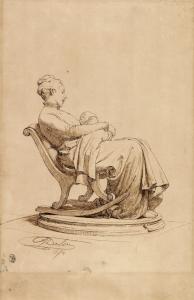Aimé-Jules Dalou (1838-1902)
Aimé-Jules Dalou was born in Paris on 31 December 1838. As the son of a modest glove maker, he soon learned to work manually and drew the attention of Jean-Baptiste Carpeaux who got him to enter the Petite Ecole (that was to become the Ecole Nationale des Arts Décoratifs) in 1853. He studied painting under the direction of Abel de Pujol (1785-1861) and painting in the studio of Francisque Duret (who had been Carpeaux’s master). The young sculptor was eventually disappointed in the academic teaching of the Ecole des Beaux-Arts. He became Carpeaux’s protégé and received private lessons from the master who also employed him as his apprentice to assist him on large scale works. In 1866, he married Irma Vuiller, who was to be of great support throughout his life.
He was deeply committed to the Republic and took part in the Commune uprising, and thus had to flee to England in 1871 with his family. There, the sculptor Alphonse Legros introduced him to art patrons and he thus received a commission from Queen Victoria. He quickly became a very successful artist in England and was appointed professor at the National Art Training School where he remained until 1880. He became the leading figure of “The New Sculpture”, a technique which combined sculpture and architecture. He then moved back to Paris.
He greatly admired the sculptors of the reign of Louis the 14th and, during a trip to Belgium in 1875, he was acquainted with the works of Rubens and Jordaens which inspired him later on, especially in large scale works such as the Monument to Republic (1899) or the Silenus (1885), sited in the Luxembourg garden in Paris.
In 1893, an illness severely diminished his health, and he devoted the last ten years of his life to his master piece: the Monument to Workers, which he didn’t complete. He passed away in Paris in 1902.

